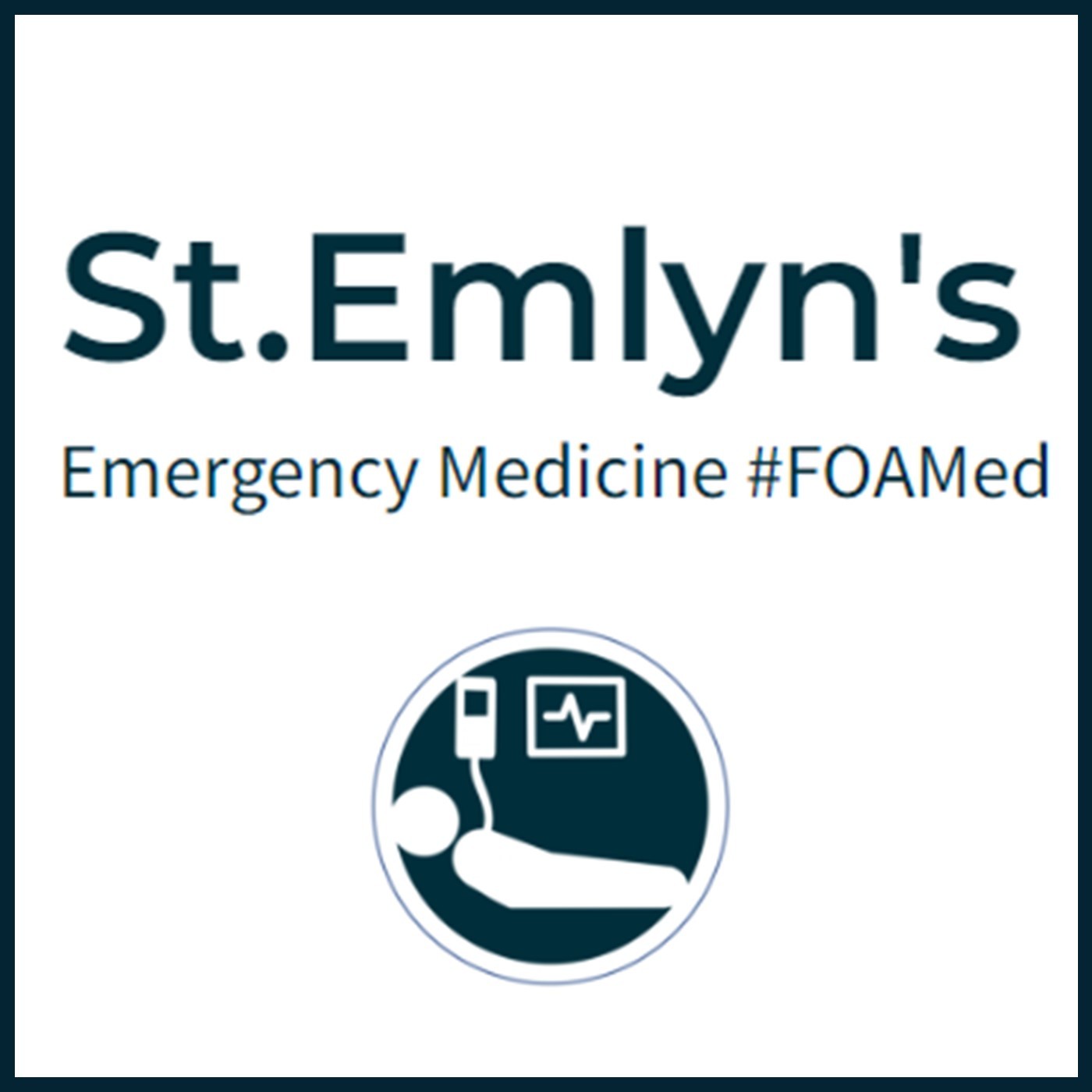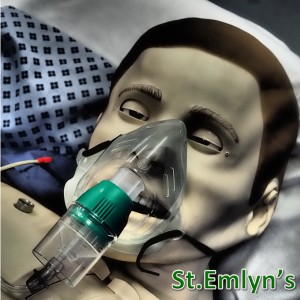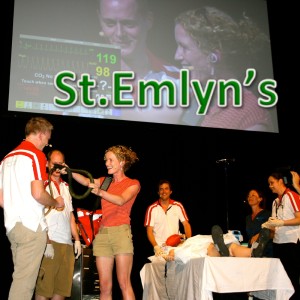
1.3M
Downloads
272
Episodes
A UK based Emergency Medicine podcast for anyone who works in emergency care. The St Emlyn ’s team are all passionate educators and clinicians who strive to bring you the best evidence based education. Our four pillars of learning are evidence-based medicine, clinical excellence, personal development and the philosophical overview of emergency care. We have a strong academic faculty and reputation for high quality education presented through multimedia platforms and articles. St Emlyn’s is a name given to a fictionalised emergency care system. This online clinical space is designed to allow clinical care to be discussed without compromising the safety or confidentiality of patients or clinicians.
Episodes

Tuesday Sep 30, 2014
Ep19 - In Situ and Guerrilla Sim in the ED
Tuesday Sep 30, 2014
Tuesday Sep 30, 2014
In Situ Simulation in Emergency Medicine: Insights from St. Emlyn's
Welcome to the St. Emlyn's blog. I'm Ian Beardsell, and I'm Simon Carley. Today, we're exploring in situ simulation, a vital method for improving patient care and team efficiency in emergency medicine. I'll be discussing this at UCEM, and we want to share our insights on implementing it effectively in your department.
What is In Situ Simulation?
In situ simulation takes place in your clinical environment, such as the resuscitation room or patient cubicles. Unlike traditional simulation centers that require significant resources, in situ simulation happens where you work every day. This method allows teams to practice and refine their skills in the actual setting, making training more relevant and practical.
Gorilla Simulation vs. In Situ Simulation
Gorilla simulation, a subset of in situ simulation, involves an element of surprise. It means conducting unplanned simulations during odd hours to test spontaneous team responses. For instance, pressing the resus buzzer at 3 AM with no prior warning and having the team manage a mock patient. While gorilla simulation is riskier and more challenging, it provides valuable insights into team dynamics and readiness.
The Importance of Simulation in Emergency Medicine
Initially, many clinicians, including myself, were skeptical about the impact of simulation training. However, extensive research and our experiences at St. Emlyn's show that simulation significantly improves clinical skills, team coordination, and patient outcomes. Studies have demonstrated its effectiveness across various departments, and we've observed marked improvements in team behavior, organization, and efficiency since implementing regular simulation sessions.
Overcoming Challenges in Simulation Training
Not everyone is comfortable with simulation, especially those who are more introverted or less familiar with the process. It's essential to acknowledge this and create a supportive environment. Normalizing simulation as part of routine training helps, as does ensuring that initial sessions are positive and constructive. We learned through trial and error to gauge participants' comfort levels and adjust the training accordingly.
Practical Tips for Conducting In Situ Simulation
-
Integration into Daily Routine: Conduct simulations around handover times, usually at 8 AM. This timing ensures double staffing, and if handover finishes early, the simulation can proceed without disrupting the department's workflow.
-
Multi-professional Participation: Involving nurses, healthcare support workers, radiographers, and other relevant staff enhances the realism and effectiveness of the simulation. For example, if a scenario involves a CT scan, we physically take the mannequin to the CT scanner.
-
Patient and Staff Engagement: Inform patients and staff beforehand to gain their support. Most patients are understanding and even find it interesting when they know a training exercise is happening.
-
Handling Distractions: Real-world distractions are an integral part of emergency medicine. Incorporating these into simulations teaches teams how to manage interruptions effectively.
Securing Buy-in from Your Department
Gaining support from senior clinicians and nursing leaders is vital. At St. Emlyn's, our clinical director and senior nurses championed the initiative. Presenting simulation as a solution to improve patient care and team coordination, backed by incident reports and data, helps persuade colleagues of its value.
Frequency and Topics for Simulation
We aim to conduct simulations three to four times a week. The focus is often on resuscitation and emergency scenarios, but we also cover other essential skills and processes, such as handover communication and teamwork. Keeping scenarios simple and relevant to daily practice ensures that training remains practical and impactful.
The Role of Debriefing
Debriefing is a critical component of simulation training. We conduct hot debriefs immediately after the simulation to capture fresh insights and feedback. This process is conversational, focusing on participants' experiences and learning points rather than a rigid critique. We also document key learning outcomes to track progress and identify areas for improvement.
Involving Other Departments
For scenarios involving multiple specialties, such as major trauma, we include relevant teams like anesthetists, surgeons, and radiologists. With high-level consent and coordination, these simulations provide comprehensive training and improve inter-departmental collaboration.
Implementing Guerrilla Simulation
While we haven't extensively practiced guerrilla simulation due to its high-risk nature, it offers significant learning opportunities. Conducting simulations in unexpected settings or times, such as a cardiac arrest in the minors area, tests the team's adaptability and response under pressure. However, it's crucial to balance this with the department's workload and stress levels to avoid overwhelming staff.
Conclusion: The Value of Simulation in Emergency Medicine
Simulation training, particularly in situ simulation, is a powerful tool for enhancing clinical skills, team dynamics, and patient care. It requires careful planning, support from leadership, and a commitment to continuous improvement. At St. Emlyn's, we've seen firsthand the positive impact of regular, practical simulation training, and we encourage other departments to adopt and adapt these practices to suit their needs.
By integrating simulation into your routine, involving multi-professional teams, and maintaining a focus on practical, relevant scenarios, you can significantly improve your department's readiness and performance. As we continue to refine our approach and share our experiences, we hope to inspire others to embrace simulation as a cornerstone of emergency medicine training.
Thank you for joining us on the St. Emlyn's blog. We look forward to sharing more insights and updates from UCEM and beyond. If you have any questions or would like to share your own experiences with simulation, please leave a comment or get in touch with us.

Tuesday Sep 23, 2014
Ep 18 - Victoria Brazil on great presentations with St.Emlyn's
Tuesday Sep 23, 2014
Tuesday Sep 23, 2014
Mastering the Art of Presentation: Insights from St. Emlyns and Victoria Brasile
Welcome to the St. Emlyns blog! I'm Iain Beardsell, and today, we're diving into a recent enlightening session with the rest of the St. Emlyns team—Simon, Nat, and Rick—alongside the exceptional educator, Victoria Brasile. Victoria recently visited the UK and shared invaluable tips on delivering excellent presentations to the emergency medical community in Manchester. For those familiar with Victoria’s engaging talks at SMACC, either in person or online, you're in for a treat as we explore the key points from this memorable evening.
The Power of a Great Presentation
Victoria Brasile's visit was a golden opportunity for the emergency medicine community. Her session focused on how to deliver impactful presentations—an essential skill for any healthcare professional. Here are the core messages she shared:
- Connect with Your Audience: Establishing a strong connection with your audience is fundamental.
- Look and Sound Great: Presentation is not just about content but also about delivery.
- Keep It Simple: Simplicity ensures clarity and retention.
These principles form the bedrock of an excellent presentation, whether addressing a large lecture hall, a small group, or even a single patient.
Connecting with the Audience
Victoria emphasized the importance of making a genuine connection with your audience. She believes that regardless of the audience size, the ability to connect on a personal level is crucial. Here’s how you can achieve this:
- Engage Interactively: Encourage audience participation by asking questions or incorporating interactive elements.
- Use Relatable Stories: Share anecdotes that resonate with the audience’s experiences.
- Maintain Eye Contact: Establishing eye contact can make your audience feel involved and valued.
During the Manchester session, Victoria practiced what she preached by fostering interaction and creating an inclusive environment. Her approach demonstrated how effective communication can transform a presentation into an engaging dialogue.
The Importance of Presentation
Victoria highlighted that looking and sounding great goes beyond mere aesthetics; it’s about being confident and authentic. Here are her top tips:
- Dress Appropriately: Your attire should be professional but comfortable, ensuring you feel confident.
- Voice Modulation: Vary your tone to maintain interest and emphasize key points.
- Body Language: Use purposeful gestures to reinforce your message and avoid distracting habits.
In Manchester, Victoria’s presentation was a masterclass in these techniques. Her confident demeanor, combined with dynamic voice modulation and engaging body language, kept the audience captivated.
Simplicity is Key
The third cornerstone of a great presentation is simplicity. Victoria advised that a clear and straightforward message is more likely to be remembered and appreciated. Here’s how to keep it simple:
- Focus on Key Points: Identify and emphasize the main takeaways.
- Avoid Jargon: Use language that is easily understandable, avoiding technical terms unless necessary.
- Visual Aids: Use slides and visuals that are clear and directly related to your points.
Victoria’s own presentations are a testament to this principle. She distilled complex information into easily digestible parts, ensuring her audience could follow along and retain the key messages.
Lessons from the St. Emlyns Team
Our team also shared their reflections and learnings from Victoria’s session:
Rick Boddie: Managing Nerves
Rick found the session particularly insightful for managing presentation nerves. He realized that controlling nerves is essential not only for the speaker but also for the audience’s comfort. Rick’s takeaway included:
- Preparation and Practice: Regular practice to build confidence.
- Breathing Techniques: Simple breathing exercises to calm nerves.
- Audience Empathy: Recognizing that the audience might be just as nervous.
Natalie May: Planning for Interaction
Natalie focused on incorporating audience interaction into her presentations. She plans to use:
- Social Media and Technology: Integrating modern tools to engage the audience.
- Structured Interactivity: Planning specific moments for audience participation.
- Pacing: Slowing down her speech to ensure clarity and engagement.
Simon Carly: First Impressions
Simon highlighted the importance of making a strong first impression. His key points included:
- Immediate Engagement: Captivating the audience right from the start.
- Preparation: Ensuring thorough preparation before stepping onto the stage.
- Action-Packed Opening: Starting with a memorable and impactful opening, akin to a Bond movie.
Enhancing Audience Interactivity
Victoria’s innovative approach to audience interaction was a standout feature of her session. She shared how dedicating a few minutes for the audience to interact amongst themselves can enhance the overall experience. This strategy not only breaks the ice but also makes the audience feel more connected and engaged. During her SMACC Gold talk, Victoria’s use of theatre—changing the stage setup and creating a visually intriguing environment—demonstrated how a bit of drama can capture and hold the audience’s attention.
Conclusion: The Three Pillars of a Great Presentation
Victoria Brasile’s session at Manchester reinforced the three pillars of a great presentation: connecting with the audience, looking and sounding great, and keeping it simple. These principles are not just theoretical; they are actionable strategies that any speaker can implement to enhance their presentations. The St. Emlyns team’s reflections further underscore the importance of preparation, interaction, and first impressions.
As we continue to learn and grow in our professional journeys, let’s keep these valuable lessons in mind. Whether you’re presenting at a conference, teaching a class, or communicating with patients, these insights will help you deliver your message more effectively and confidently.
Stay tuned for more insights and tips from the St. Emlyns team. We hope you enjoyed this deep dive into the art of presentation. Until next time, embrace your emergency medicine practice with enthusiasm and excellence!
For more resources and links to Victoria Brasile’s talks, visit our blog site. If you have any questions or thoughts to share, please leave a comment below. We’d love to hear from you!

Friday Sep 12, 2014
Ep 17 - Diffuse Axonal Injury with John Hell
Friday Sep 12, 2014
Friday Sep 12, 2014
Understanding and Managing Diffuse Axonal Injury in Neurointensive Care
Welcome to the St Emlyn’s blog. I’m Iain Beardsell, and today we delve into the complex and crucial topic of diffuse axonal injury (DAI) with insights from John Hell, a consultant in Neurointensive Care at the University Hospital of Southampton and former director of the Wessex Neuroscience’s Intensive Care Unit. With his extensive experience and co-authorship of the Neurointensive Care guidelines, John provides a comprehensive overview of DAI, its pathophysiology, management, and prognosis.
What is Diffuse Axonal Injury?
Diffuse axonal injury is a type of traumatic brain injury where the brain’s axons are sheared due to rapid acceleration or deceleration forces. This can occur in various scenarios, from minor to severe head injuries. The axons, which connect the grey matter (cell bodies) on the brain's surface to the white matter (nerve fibers) inside, are particularly susceptible to damage when subjected to such forces.
Pathophysiology of Diffuse Axonal Injury
The pathophysiology of DAI involves axonal shearing due to differing densities and connections between grey and white matter. When the brain moves at different rates within the skull during an injury, this shearing occurs. Initially, this stretching does not necessarily rupture the axons but causes them to swell and release mediators. These mediators lead to further axonal breakdown and secondary brain injury characterized by cerebral edema, increased intracranial pressure (ICP), and restricted diffusion of glucose and oxygen.
Clinical Presentation and Diagnosis
DAI can be challenging to diagnose initially, as early imaging might show minimal changes. However, small petechial hemorrhages at the grey-white matter interface can be indicative. These are more evident on MRI scans or repeat CT scans after 6 to 24 hours. Clinicians should be vigilant about mechanisms of injury, Glasgow Coma Scale (GCS) scores, and clinical presentation to suspect DAI.
Management Strategies in Neurointensive Care
The management of patients with DAI involves a multi-faceted approach focused on stabilizing and maintaining normal physiological parameters. Key steps include:
-
Initial Stabilization: Ensure normal blood pressure, oxygenation (PACO2 and PIO2), and venous drainage from the head by positioning the patient appropriately and avoiding obstructions like tight cervical collars.
-
Monitoring and Imaging: Initial imaging may show little, but repeat CT or MRI scans can reveal the extent of the injury. Placing an ICP monitor helps in maintaining adequate cerebral perfusion pressure (CPP) as ICP rises over 72 to 96 hours.
-
Intravenous Fluids: Use of normal saline is recommended due to its osmolality. Other fluids like Hartmann's, which are hypo-osmolar, can exacerbate cerebral edema by diluting plasma.
-
Anticoagulation Management: Reversal of anticoagulation and ensuring normal platelet function is crucial. Patients on anticoagulants should have these reversed immediately, and those on antiplatelet agents should receive platelet transfusions if still bleeding.
Prognosis and Outcomes
Prognosis in DAI is variable and often unpredictable based on initial presentation. While patients with poor GCS scores tend to do worse on average, individual outcomes can vary widely. Aggressive monitoring and management in neurointensive care units have shown that many patients can recover to independence and good quality of life, challenging the previous perception of uniformly poor outcomes.
Practical Insights for Emergency and Pre-Hospital Care
In emergency and pre-hospital settings, early interventions can significantly impact outcomes. Prioritizing normal physiological parameters, using appropriate induction agents, and ensuring timely referral to neurointensive care are essential steps. For instance, thiopental is recommended for induction in hemodynamically stable patients with isolated head injuries due to its efficacy in minimizing cerebral metabolic rate for oxygen (CMRO2). For unstable patients, ketamine remains a safe alternative despite old concerns about its use in head injuries.
Case Study and Practical Application
Consider a hypothetical case of a 45-year-old cyclist involved in a high-speed accident, resulting in severe head injury without intracranial bleed but with suspected DAI. The patient is intubated and ventilated by the pre-hospital team and transferred to a major trauma center. Initial CT shows minimal injury, but due to the mechanism and presentation, DAI is suspected.
In neurointensive care, management focuses on:
- Stabilization: Ensuring normal blood pressure, oxygenation, and venous drainage.
- Monitoring: Placing an ICP monitor and repeating imaging at 6, 12, or 24-hour intervals.
- Fluid Management: Using normal saline to maintain plasma osmolality.
- Anticoagulation Reversal: Reversing any anticoagulation and ensuring normal platelet function.
Over the next 72 to 96 hours, the patient’s condition is closely monitored, with adjustments made based on ICP readings and repeat imaging. The interdisciplinary team works together to minimize secondary brain injury and support recovery.
The Role of Education and Ongoing Research
Continuous education and staying updated with the latest guidelines and research are crucial for healthcare professionals managing traumatic brain injuries. The Neurointensive Care guidelines co-authored by John Hell and his team are a valuable resource available online, providing evidence-based practices for managing these complex cases.
Conclusion
Diffuse axonal injury remains a significant challenge in neurointensive care, requiring a comprehensive and multidisciplinary approach for optimal outcomes. Early recognition, aggressive management, and ongoing research are key to improving the prognosis for patients with DAI. By maintaining normal physiological parameters, utilizing appropriate fluids, and implementing timely interventions, healthcare professionals can make a substantial difference in the recovery and quality of life for these patients.
Thank you for joining us on the St Emlyn’s blog. We hope this detailed exploration of DAI provides valuable insights for your practice. Stay tuned for more discussions on critical topics in emergency and intensive care medicine.
